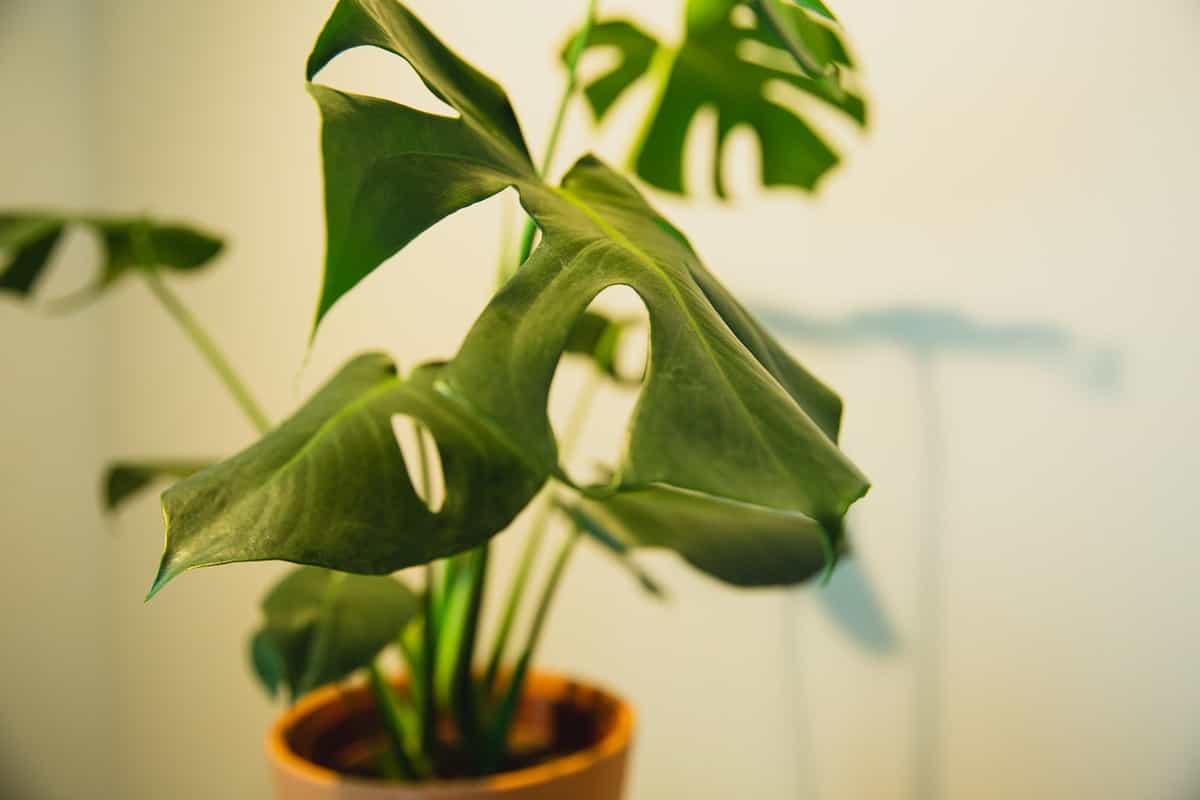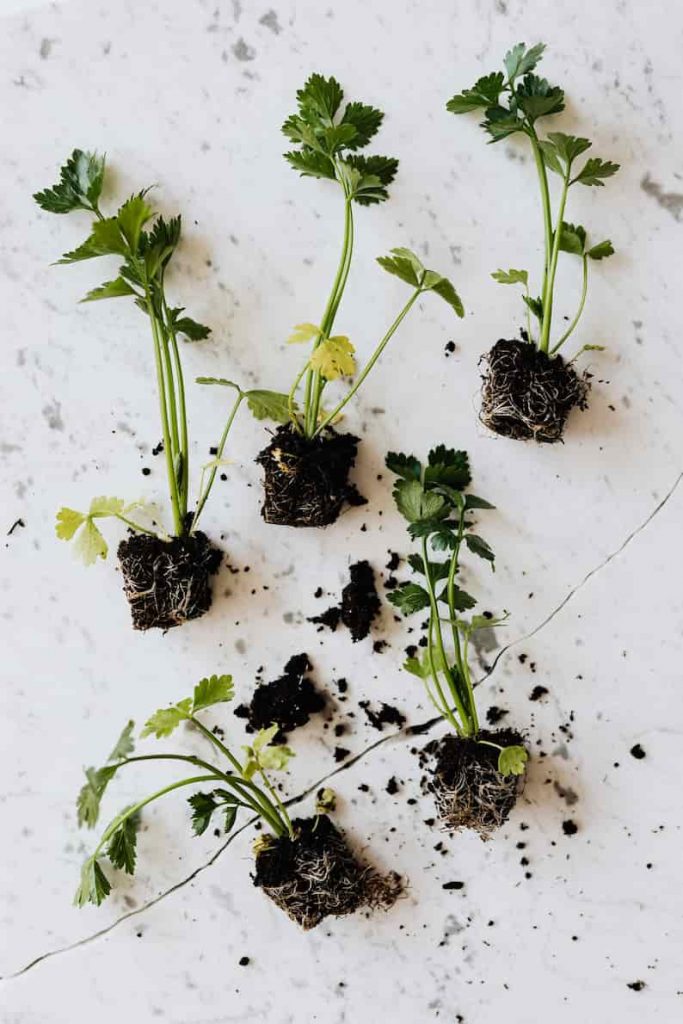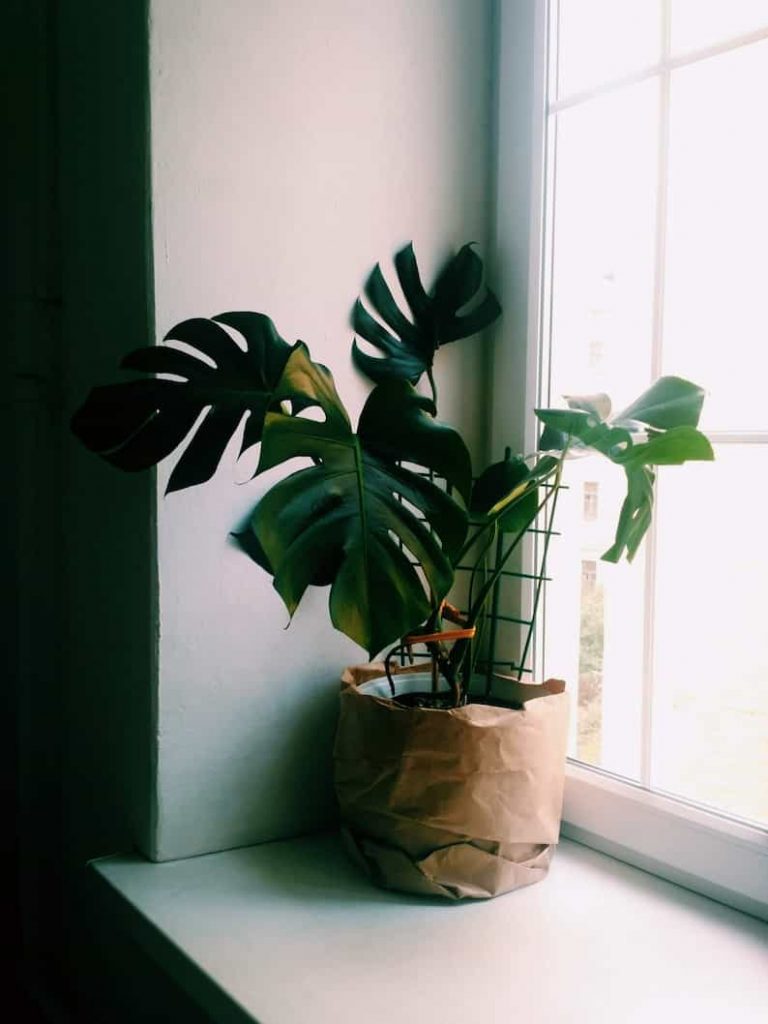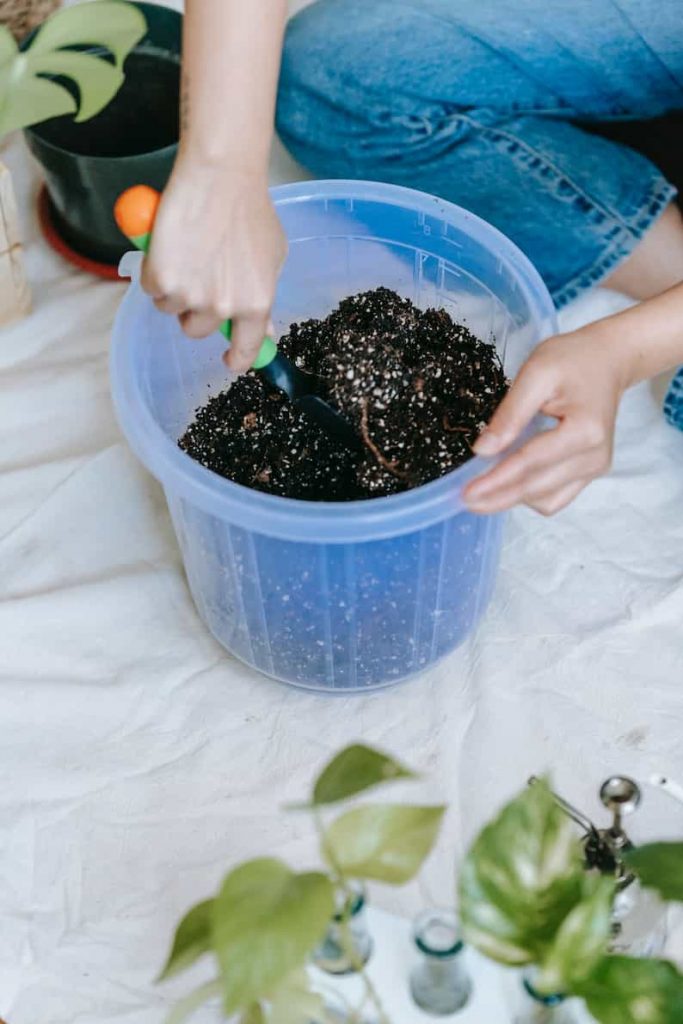The speed at which your Monstera grows, especially compared to other houseplants, is pretty incredible. Unfortunately, this means that it can outgrow its pot faster than some of the other plants in your collection.
And if you don’t notice your Monstera’s rapid growth in time, it can have serious implications for the health of your plant. This includes that you could find yourself facing the question of how do you fix a root bound Monstera before it’s too late.
Like most plants, Monstera don’t like to be root bound and so this is certainly a potential problem you need to keep in mind, especially if you notice your plant looking less healthy than normal.
Fortunately, there’s a relatively simple solution to separate root bound Monstera that won’t take you much work at all to follow. And as you’ll see, by adding an occasional root check (don’t worry, I’ll also run through below how you can know if your Monstera is rootbound!) into your regular plant care schedule, you can easily avoid this issue going forward.

Table of Contents
Do Monstera like to be root bound?
No, Monstera plants do not like to be root bound. Without space for the roots to continually grow and access more nutrients and water in the soil, the plant will not be able to properly grow and support itself.
This is why young plants should be repotted once a year since they are relatively fast growers for the first four years or so. Older plants can be repotted or checked every two to three years.
Root bound plants are stressed plants, and they will not fare as well as they otherwise could, even in otherwise optimal growing conditions. They have to focus their limited amount of energy on survival, instead of putting out new growth.
In fact, if you’ve noticed that there is no new growth on your Monstera or, when this is still happening, that your Monstera leaves aren’t splitting even after new leaves develop, this could be why. This is why Monstera plants need to be checked and repotted when it’s needed.
What does it mean for a plant to be root bound?
When someone says a plant is “root bound” or “pot bound,” it essentially means the plant has outgrown its pot and its roots are out of room. If a plant is left in a pot that is too small for it, the roots will start to grow in circles along the outer edge of the pot
The name comes from the fact that the plant’s roots are “bound” by the amount of space the pot provides. In these cases, over time, its roots will wrap around themselves and leave no room for water, air, or nutrients to permeate the soil.

If you’ve ever heard of foot binding, the idea is very similar, with the feet becoming disfigured as they remain confined to a small space. The same sort of thing happens with plant roots when they become pot bound or root bound.
Since some varieties of Monstera can grow up to twelve feet tall when growing outdoors, and to a certain extent indoors, its root system is even more important than in other small house plants.
It is an unfortunate truth but many Monstera plants grown indoors or outdoors in containers fail to reach their full beauty and magnitude simply because they are kept in containers far too small for their root systems.
Is it OK for Monstera to be root bound?
No, it is not ok for your Monstera plants to remain root bound for a long length of time. The plant may initially survive but, over time, it will become very stressed and start to look less well.
Because of their ease of care compared to some other plants and their faster growth in optimal conditions, a healthy Monstera can end up growing to three to five feet indoors. It is important to remember that as the plant is growing up, its roots are also trying to grow outward to compensate for all that foliage it is trying to support.

As I’ll outline below, repotting your Monstera is the solution here. The best time to replant your Monstera is in the early spring as you are entering the warmer months of the year.
However, once the plants begin hitting around the three foot mark, it can become challenging to repot them easily. To prepare for this, when repotting a Monstera, a much larger pot should be provided that can accommodate the next few years of growth and save you from at least one cumbersome repotting.
How do you fix root bound Monstera?
To fix a root bound Monstera, you need to either repot your plant into a bigger pot or split your Monstera into two or more smaller plants. With either option, this will ensure that the roots have enough space for your plant to continue to thrive.
If you discover your Swiss Cheese plant is root bound, like if your Monstera is drooping suddenly, the time to take action is sooner rather than later to be sure. The sooner you give your plant more room to grow, the sooner it can get back to growing and producing healthy leaves and new stems.
How do you repot a root bound Monstera plant?
Repotting a root bound Monstera plant is easy and really only requires a few simple steps:
- Remove the plant from its pot and carefully unwrap some roots, so they are not continuing to grow in the circular restrictive way.
- Put soil down in the bottom of the new pot, making sure to add enough so that when the Monster is placed inside, the top of the root ball is a few inches under the top of the new pot.
- Gently support the plant with one hand and begin filling in around the roots with fresh soil, gently tapping down the soil to support the plant but ensuring you are not removing all the air pockets in the process.
- Fill the pot with soil until you reach the top of the root ball of the plant and stop, making sure you are not burying the plant too deeply into the pot.
- Water the plant and add in a support stake for your Monstera or trellis if you want to encourage your Monstera to climb as it continues to grow in its new pot.
Best soil for Monsteras
Specially designed soil for your Monstera. Light and well-draining, making it perfect for avoiding root rot, while being packed with just the right nutrients to keep your plant happy.
And that’s really all you need to do to move your Monstera from its small pot into something bigger that’s going to be the best pot for your Monstera, especially given how much more suitable for its continued growth this will likely be. As mentioned, in terms of how to fix a rootbound plant, either repotting or splitting your Monstera will do the job, with both basically requiring the same amount of work.
Its roots will appreciate having more space to expand and grow, and your plant will grow tremendously in the time to come. In addition, repotting or splitting your previously root bound Monstera gives the plant the chance to also get fresh soil, which will provide the plant with more nutrients to grow and will keep it happy and healthy.
Safety concern
Most houseplants, including Monstera, produce a substance known as calcium oxalate. This clear or whitish colored sap means that the Monstera is toxic to cats, dogs and other pets, as well as humans. If ingested, it could lead to poisoning, and if it comes in contact with skin, it can lead to skin irritation. Both can make a person very ill and, in some cases, can be fatal.
This is why it is recommended you should:
- Wear gloves when working with your Monstera plant
- Wash your hands very well after repotting or trimming your Monstera. Any sap that gets onto your skin, even through work gloves, needs to be washed off before you eat or go to the bathroom.
- Avoid touching your face to keep from accidentally getting the sap in your eyes or mouth while you are working.
How do you split a root bound Monstera?
If you decide to split a larger root bound Monstera into several smaller plants as a way to deal with the issue, this can be done by following these simple steps:
- Water the Monstera plant thoroughly the day before splitting to help loosen up the soil and ensure the roots are not overly stressed before you begin stressing it more by cutting it.
- Take your plant out of the pot following the same steps outlined above for the other methods.
- Using a sterile knife or clippers, cut through the roots and the junction point of the stems, looking for natural branches and offshoots.
- Make sure each new plant that you cut off has enough roots and leaves to grow, remembering it is better to have two healthy plants than three stressed plants.
- Take your new pots and make sure they are filled with potting mix and add in a slow-release fertilizer for your Monstera if you so choose.
- Supporting the plant so the top of the roots are a few inches below the lip of the pot, begin filling in the new soil and tapping it down gently, so it anchors the roots and supports the plant in the new pot.
- Fill the pot up with soil, spreading a thin layer over the top most roots, so they are not exposed but taking care not to bury them too deeply either.
- Tap the pot on your work table gently and make sure the plant can stand up on its own and then water the plant thoroughly.
- Care for it as you would normally, making note that some leaves may turn yellow and fall off as it adjusts to the new growing conditions.
You will start noticing new growth within a few weeks. Note also that your (now two!) Monstera will need more care and attention than usual during this time as it may be in a state of shock following the splitting and replanting. This is very normal and, with some time, your plants should recover.
How do you separate root bound Monstera?
If you do not wish to transplant your Swiss Cheese plant, you can separate a root bound Monstera by pruning back the roots so it fits better into its current pot. Simply remove the plant like you would for repotting and trim back the bottom portion of the root ball carefully with clean, sharp scissors or clippers.

Once the roots have been pruned back on your Monstera, you can replant in the same pot with fresh soil. One key thing to remember when choosing to prune the roots rather than repotting is that it will only give you so much new space to work with and should only be done as a one-time solution. The next time the plant becomes root bound it will need to be moved into a larger pot.
To avoid over-stressing the plant, when pruning roots be careful to not remove more than one-third of the root system. The roots are what supply the plant with water and nutrients and the majority of that comes from the tips of the roots. Removing too much of the root system can damage the plant and cause it to struggle to rebound.
How do you know if Monstera is root bound?
While it is all well and good to know what to do to take care of a Monstera plant that has become root bound, you may be wondering if there are any signs that may indicate a Monster is getting too crowded in its pot. Thankfully, there are some things to look for ahead of a serious issue arising.
The most common root bound Monstera signs include
- Soil dries up quickly and water seems to almost instantly flow through the pot when plants are watered.
- Your plant shows signs of dehydration or your Monstera needs to be watered more often than it did before.
- Droopy and curling or your Monstera leaves turning yellow, when these issues cannot be explained by over or under watering or insect damage.
- Stunted growth and a decrease in the overall health, vigor, color, and appearance of the Monstera plant.
- Roots are spiraling around the top or bottom of the pot or actively growing out of the drainage holes
- Pot starts expanding, warping, or splitting if it is a plastic pot, or it starts to crack and break down if it’s a heavier pot.
Most of the signs of a root bound Monstera could be signs of other issues. This is why it is important to check root balls often and, if issues arise that cannot be corrected with other general practices, then root binding should be expected.

In its natural environment the Swiss Cheese plants like to grow on other trees or stumps. Its roots will attach to the bark and stems and use the trees to support its massive size and weight. Indoors however, it melds to the shape of the container it is planted in and is greatly constrained by the pot it is growing in.
In fact, if a Monstera has been grown indoors for more than 2 -3 years and is not in a massive pot to begin with, chances are very high that it has reached the point of being root bound – and possibly very root bound at that.
Knowing how to deal with root bound plants can help you ensure your Monstera plants stay healthy and beautiful year after year. Following these tips and keeping these handy pointers in mind will make it easier to deal with issues that arise.
How to check if your Monstera is root bound
You need to check your plant to determine if it’s root bounded or not, which can be done by following these steps below:
- Lay the container on its side and gently support the plant’s stem and leave to avoid breaking them or damaging them.
- Loosen up the soil by gently squeezing on the pot if it is a thin plastic pot or use a stick or ruler to loosen the soil in a heavier pot.
- Do not squeeze or tug on your Monstera’s stem if it’s not coming out, but rather try to slide it out and let gravity help move the plant and dirt ball.
- Gently slide the plant out once it loosens up and pull it out, making note that you might have to break the container or cut it off if the plant is stuck.
- Once you have your Monstera out, you can then carefully examine the root ball of the plant to see if it is root bound.
If your Monstera plant’s root is tangled together and has taken the shape of its container, leaving only a small amount of soil in there, then your plant is definitely root-bound. Another sign is if you pick up the plant by the root ball and little to no soil can be seen in and among the roots.
A healthy root ball will have large white roots and a good bit of loose soil around them. Anything other than that and there are definitely issues with the root system that need to be addressed.
Fortunately, simply follow the steps outlined in this article and you and your Monstera will be right back on track!

